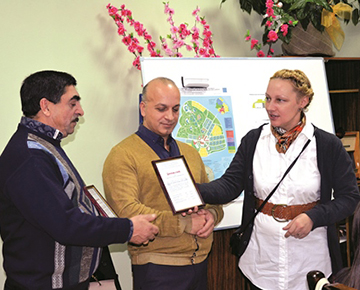Belarusians have been known for their tolerance for centuries. At present, people of 140 nationalities live here, in peace and concord. According to the 2009 census, there were 7,000 Gypsies living in Belarus. Now, the Gypsy community estimates that the figure is closer to 60,000.

Scientific leader of Roma Integration programme, N. Kutuzova, bestows diploma on K. Bankovsky
Not long ago, Minsk’s International Contest of Young Architects presented a project to reconstruct Titovka settlement, for Gypsies, near Bobruisk; the winning entry is designed by students from the Belarusian Polytechnic University and the Belarusian Academy of Arts, Yelizaveta Chepikova and Dmitry Kutuzov.
A display of photos and sketches of the future settlement is open to the public for a month, including works by non-winning finalists. The idea of reconstructing a residential district for this purpose was proposed some time back, with various zones of activity: for children, for relaxation, for businesses and an area of natural beauty.
A museum of Gypsy culture and lifestyle is also planned, housed inside a traditional ‘caravan’. It may be sited at the location of the Festival of National Cultures, in Grodno; Bobruisk’s chief architect is now studying the proposal.
The Titovka site is currently in much need of development, and lacks employment opportunities, so the project aims to revitalise the area. Gypsy communities tend to be located outside cities, such as in Kolodishchi (near Minsk), close to Vitebsk and to the city of Kalinkovichi in the Gomel Region. To enhance their integration, and their rich traditions, into Belarusian life, specialists from the National Academy of Sciences, from the Republican Centre of National Cultures and from the Foreign Ministry have developed the Roma Integration programme. This aims to teach people of Roma ethnicity local language skills, to help them communicate with officials within ministries and agencies.
International Romani Language Day is celebrated on November 5th. On the eve of the holiday, the Deputy Chairman of the Belarusian Gypsy Diaspora — Artur Gomonov (from Minsk), joined the Head of Oshmyany’s Gypsy Community — Artur Yegorov, and various representatives of the community in discussing urgent issues. Among those present were Alena Martinkevich (from Bobruisk), Konstantin and Raisa Bankovsky (from Vitebsk) and Viсtor Murachkovsky (from Nesvizh).
An awards ceremony to recognise those who have been learning through the programme was recently held. Young Alena Martinkevich’s grandfather, taking her diploma into his hands, admitted, “Initially, I was against Alena’s participation. Later, people with all sorts of requests came to our house: asking us to register a child at school and at the policlinic, or to register lost documents. I then realised that I should help my granddaughter. I’m the first ‘pupil’ to enlist for next year’s lessons.”
Natalia Kutuzova, who is heading the programme, explains, “In 2014, our experts collected information on all Belarusian regions, meeting local authorities. Then, in June 2015, we opened our training course on communication.”
Lessons took place over five months, including work explaining the law ‘On Citizens’ Applications’ and other information on Belarusian legislation. “We aim to help the Gypsy community talk to authorities in a single language,” stresses Ms. Kutuzova. However, she believes, education is ‘the key aspect’.
Ms. Kutuzova comments, “In neighbouring countries, many problems are successfully solved via mini-programmes, including pre-school training for Gypsy children. A teacher who knows their language (most often a representative of the community) teaches them elementary behaviour, such as sitting quietly and listening when a teacher is speaking.”
The Deputy Chairman of the Belarusian Gypsy Diaspora, Artur Gomonov, believes that schools should be integrated, with Belarusian and Gypsy children learning alongside one another. It is for this reason that experts have rejected a European project to establish a separate Gypsy community, not wishing to encourage isolation.
Integrated classes have proven successful this year, with 47 Gypsy children attending a Slutsk secondary school; many have been encouraged by Victor Murachkovsky — a Belarusian Gypsy Diaspora activist. His Let’s Prepare Children for School campaign, launched on September 1st, has provided school kits to Gypsy families who have many children and only a small income.
The Titovka school is unique, attended by 123 pupils, of whom 100 are from Roma families. The Roma Integration project has presented textbooks and books, including the Gypsy ABC and Gypsy Fairy-tales (presented by St. Petersburg’s Memorial Anti-discrimination Centre).
Roma Integration is going well, delighting its organisers and those taking part. Mr. Gomonov notes that the Gypsy community is traditionally closed, requiring negotiators to be experienced and well-educated, as well as being experts in Belarusian legislation.
According to statistics, around 80 percent of Gypsy children in Belarus receive secondary and elementary education. However, most only finish basic courses; only 2 percent go on to higher education. Around 17 percent have secondary, professional-technical or secondary-special education.
МТ REFERENCE:
At the moment, six Gypsy public organisations are registered in Belarus. In 1997, the Belarusian Association of Gypsies — Roma — was established and, in 1998, the Belarusian Gypsy Diaspora (with a branch in Vitebsk) was set up. In addition, there is: the International Public Organisation of Gypsies — Vozrozhdenie (Revival); the Oshmyany Gypsy Community; and the Gomel Inter-Regional Roma Community.
By Yekaterina Medvedskaya











